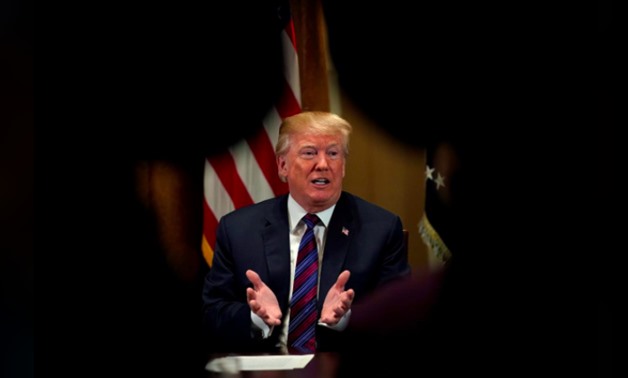
U.S. President Donald Trump speaks during a meeting with governors and members of Congress at the White House in Washington, U.S., April 12, 2018. REUTERS/Kevin Lamarque
22 August 2018: “Not thrilled” may become a regular state of mind for U.S. President Donald Trump in the months ahead, as the Federal Reserve is likely to press on with interest rate rises to recalibrate policy for an economy boosted by the president’s own tax cuts.
Trump used the phrase “not thrilled” on Monday to describe his reaction to rate hikes under Fed Chair Jerome Powell who Trump selected for the job six months ago. Trump went on to say he wanted more help for the economy from the Fed.
A day later, Dallas Fed President Robert Kaplan, who tends to align his views with those of Powell, released an essay that signaled he views another three or four rate hikes as “the best chance” for delivering continued economic growth, given the strength of the economy.
While not framed as a response to the president, the essay made clear that Kaplan sees Trump’s $1.5 trillion in tax cuts and this year’s budget deal as helping to drive unemployment down and inflation back to the Fed’s 2.0-percent target, a view shared broadly at the Fed.
Without gradual rate interest rate rises, policymakers worry, the economy could overheat, forcing the Fed to raise them aggressively and possibly sending the United States into recession.
The Fed has raised interest rates twice this year already and is expected to do so again next month with consumer price inflation rising to 2.9 percent in July, its highest level in six years, and unemployment at 3.9 percent, the lowest level in about 20 years.
Most analysts think that Trump’s criticism will have little effect on the Fed’s rate-hike plans, given the U.S. central bank’s legal independence. Traders still expect, as they did before Trump’s comments, that the Fed will lift rates in September and again in December, at which point short-term term borrowing costs should be somewhere between 2.0 percent and 2.25 percent.
But next year the situation gets tricky, said Eaton Vance portfolio manager Eric Stein.
“Forgetting his comments, adding fiscal stimulus this late in the cycle is ... unusual, and probably makes the job more complicated for the Fed,” he said.
Trump’s efforts to use import tariffs to force concessions on trade from China and other countries also creates potential challenges for the Fed, Stein said, because while the tariffs can boost prices, they may also lead to slower economic growth.
But managing such trade-offs is well in the future and so far trade policy tensions have hardly made a dent in the economic outlook.
When Powell speaks Friday at an annual global central bankers meeting in Jackson Hole, Wyoming, Trump’s comments may prompt some uncomfortable questions, “but do not alter the economic backdrop or Fed policy going forward,” economists for RBC Capital Markets wrote Tuesday.
NOMINATIONS
Beyond criticizing the Fed for raising rates, there’s little Trump can do about it. The president does choose members of the policy-setting Fed Board, and in addition to Powell, he has appointed one Fed governor and nominated three others. None appears to be particularly eager to loosen monetary policy.
“I take comfort from Trump’s nominations so far,” said James McCann, senior global economist for Aberdeen Standard Investments.
There are a total of seven governors on the Fed Board, all of whom have a vote on setting interest rates, and Trump still has one remaining vacancy to fill should his current slate of nominees win approval from the Senate.
Trump has no say over the choice of the 12 regional Fed presidents like the Dallas Fed’s Kaplan. Five of them vote on setting policy at each meeting with voting assignments rotated on an annual basis.
Beyond Trump’s fiscal and trade policies, there is plenty that the Fed will need to factor in as it makes rate-hike decisions, including the state of the global economy and financial markets.
Already, tighter U.S monetary policy has contributed to strain in emerging markets like Turkey, and any disruption overseas could potentially feed back into U.S. financial markets and ultimately the country’s growth trajectory.
Trump's Fed attack sees dollar dive and emerging markets rally
And a narrow gap between short-term and long-term U.S. Treasury debt yields has the attention of several Fed policymakers as a signal that growth is set to slow, and further rate hikes could trigger a recession.
Most policymakers believe the Fed cannot raise rates much beyond 2.9 percent, a level they see as “neutral” for the economy, without borrowing costs really beginning to drag on growth.
“It’s likely that in either December or March the Fed will pause the rate hikes, not because of Trump’s pressure but because it would be the right thing to do, with the funds rate approaching neutral and still likely no inflation threat,” said Cornerstone Macro economist Roberto Perli. “One might be tempted to think that all the President is doing is positioning himself for taking credit for the eventual inevitable pause.”


Comments
Leave a Comment